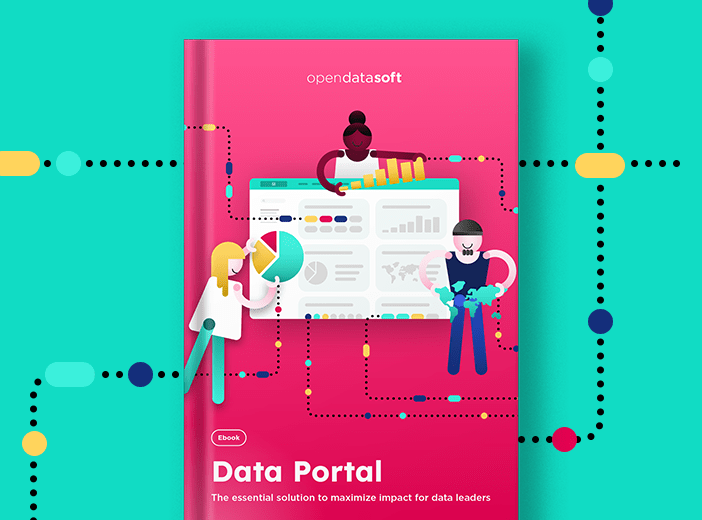Data portals: a major asset for players in the energy sector
An in-depth exploration of the impact of data portals in the energy sector. From decarbonization to collaborative innovation, discover how data drives innovation and strengthens regulatory compliance.

How can the implementation of data portals help players in the energy sector meet the many challenges they face? To what extent do they support organizations in achieving their objectives? What are the different types of data portals, and what needs do they meet?
At a high level, energy sector data helps provide ways to overcome the challenges of climate change and global warming, especially around decarbonization, energy supply and pricing. However, although the energy industry today produces large volumes of data, some organizations still find it difficult to use this information efficiently, both internally and across their wider business ecosystems. This can be due to difficulty in sharing datasets, unclear visualizations, a lack of accurate forecasts or an under-developed data culture. The facts are clear: data often remains in the hands of Chief Data Officers (CDOs), data analysts, and a few specialist managers, and is neither used nor valued in the wider ecosystem.
At Opendatasoft, we’re convinced that the implementation of data portals can remove these difficulties by putting data at the heart of how organizations in the energy sector operate. This article examines – in depth – how data portals help utilities to respond to today’s challenges, from decarbonization to fostering collaborative innovation, meeting regulatory compliance targets and empowering consumers.
What is a data portal? Definition
Before turning to the challenges faced by energy players and the solutions that data – and more specifically data portals – can provide, let’s quickly recall what they are.
A data portal is an application or website that provides access to data assets from multiple different sources, making them available in a controlled way to data consumers, who might be employees, partners, or customers. In addition to centralizing data from multiple sources in a single place, a portal makes it possible to perform precise searches to find specific data, visualize it in different forms, cross-reference it, share it, and reuse it. In short, the portal facilitates access to data assets and ensures they deliver value for the entire organization.
NOTE: In our latest study – carried out in conjunction with Odoxa – we found that 85% of data leaders said data management was a priority for their organization. Data portals enable this requirement to be met at an operational level.
Issues and major challenges facing energy players
As mentioned in the introduction, energy players face a number of challenges. It’s in this context and environment that data portals can play a vital role.
Meeting the objectives of the energy transition
The goal of decarbonization by 2050, which was set at COP21, is transforming how energy players operate, putting the sector firmly in the spotlight.
Shareholders, regulators and consumers are all closely monitoring how energy players are transitioning from fossil fuel-based production. Without adequate, concrete progress, utilities could face tighter regulation to force them to change. In addition to the major challenge of changing the sources used for energy production, utilities also need to rethink and update their distribution networks to make them more agile and adapted to changing needs.
As a society, how can we balance intermittent energy production from renewable sources such as wind and solar with our increasing need for electricity, such as to power electric vehicles and replace gas in heating our homes? This all means that achieving carbon neutrality requires innovation and a restructuring of traditional operating models.
Data portals help underpin greater innovation and more intelligent network management:
UK Power Networks, for example, uses a data portal to share information in order to optimize its power distribution network. By collecting and analyzing data in real time, the company has improved network resilience, offering valuable lessons for other companies in the sector. To increase effectiveness, UK Power Networks has chosen to make its data management methods, developed in partnership with the Open Data Institute, available to the entire industry.
In Portugal, EDP has transformed its approach to innovation by using a data portal. Thanks to sharing its real-time data, it has been able to reduce its carbon emissions and optimize its operations. It has achieved this by creating a collaborative community that works together to find solutions to real-life energy problems, by sharing datasets with universities, researchers and startups.
Improving internal efficiency
To meet their challenges energy players need to constantly improve their internal efficiency. Decision-making needs to be better-informed and faster, and data portals can play a decisive role.
By centralizing high quality, trustworthy data through a data portal, improving network forecasting through artificial intelligence, and sharing data on a much wider scale, rather than solely with a limited number of data analysts, decision-making is dramatically improved. Combining data from different areas, such as production, distribution and marketing, leads to better decisions and drastically improves internal processes. Essentially portals allow utilities to visualize data clearly and simply – making it understandable to as many people as possible. This is as important as collecting data itself when it comes to improving organizational efficiency.
Offering better services to consumers
Energy players face issues around customer experience and ensuring that customers remain loyal. Achieving this above all requires them to build a relationship of trust. Data is central to delivering this improved, trust-based experience.
For example, creating a personalized customer app that shares key data on their real-time energy consumption and environmental impact, can encourage customers to be more aware of – and reduce – their energy consumption. Sharing information via apps and connected devices strengthens the relationship between customers and their energy suppliers, empowering consumers and helping to support behavioral change to drive the energy transition.
In addition to improving the user experience and consumer loyalty, data portals enable utilities to better understand customer needs and develop tailored offers and services. In France, Enedis has integrated a space on its open data portal that displays the energy efficiency (thermosensitivity) of homes. This makes it possible to discover areas within towns or cities where temperature variations will affect energy consumption, and thus identify homes that need to be refurbished to meet energy performance targets.
On the B2B side, Birdz, the leader in intelligent water solutions, has launched a new Dashboard as a Service offering based around the data generated by its IoT sensors, improving the experience for its customers. By subscribing to these services, customers gain access to a comprehensive management tool that enables them to improve operational efficiency by monitoring usage data and instantly detecting leaks and faults in their networks.
Data services designed to meet the needs of customers and other stakeholders can be monetized, uncovering completely new sources of revenue. It also differentiates players from their rivals, delivering competitive advantage by better meeting customer expectations.
Transparency and regulatory compliance
As we said earlier, the energy sector is on the front line when it comes to environmental issues. Consumers, shareholders, and regulators expect total transparency. Sharing reliable data on a large scale is therefore crucial to reassure stakeholders and thus guarantee better risk management.
Firstly, transparency helps to guarantee compliance with regulations, such as these two examples:
- The UK Energy Data Taskforce’s Strategy for a Modern Digitalised Energy System, came into effect in 2023. This sets out five key recommendations to modernize the UK’s energy system and drive it towards a Net Zero carbon future. Data is at the heart of this, particularly around maximizing its value and visibility, moving to a model where data is presumed open, rather than closed. Companies need to publish, maintain and regularly update a Digitalisation Strategy and Digitalisation Action Plan (DSAP), which will be reviewed through external audits commissioned by regulator Ofgem.
- In the UK gas sector, Ofgem has requested a digitalization strategy and roadmaps as part of the RIIO2 network price control mechanism.
Secondly, it provides reassurance – backed up by data – about progress towards Corporate Social Responsibility (CSR) and Environmental, Social and Governance (ESG) objectives. Data portals are the perfect tools for sharing data. They enable energy suppliers to publish their data in a format that customers – and society as a whole – can easily understand.
NOTE: while this may not be the primary objective of setting up a data portal, it is worth acknowledging that the resulting openness and transparency can also help to improve the organization’s external corporate reputation.
The benefits of the 3 types of data portal for the energy sector
In the examples we discussed above, we explained the different types and uses of data portals. Our solution supports players in three main areas:
Internal data portal
Internal data portals are used solely by employees. Their primary objective is to improve operational efficiency, reduce costs, make better decisions, optimize collaboration and deliver a holistic, clear view of the organization’s entire operations. These portals are based on granular management of access rights, guaranteeing data security, while ensuring relevant data is visible to employees in specific roles.
Data portal for partners and customers
As we’ve seen with the Birdz and EDP examples, external data portals enable new revenues to be generated through the introduction of new services, and encourage innovation by sharing high value-added data. They can be joint portals where each stakeholder contributes data on an equal footing, or more advanced solutions where data services are monetized for customers.
Open data portals
Open data portals – known as open data – facilitate the free, reusable sharing of information by making it accessible to all via the internet. Initially designed to meet regulatory requirements in the public sector, these portals have spread to the private sector, improving stakeholder engagement, corporate reputation and transparency. They therefore make it possible to meet regulatory requirements while also improving customer and stakeholder confidence.
Alternatively, some organizations choose to create a single portal to meet all three of these needs. These hybrid portals include granular access rights management to ensure that different types of users can only access relevant data assets to ensure confidentiality.
The need to spread a data culture
If data portals are necessary to meet the challenges faced by players in the energy sector, to be successful their implementation must be backed up by the adoption of a data culture at all levels throughout the organization. Lack of a data culture will slow down the sharing and use of data across the organization.
A previous survey revealed a startling figure: 56% of decision-makers report that their lack of data culture is an obstacle to the successful completion of their projects. This demonstrates the importance of raising awareness about data and educating employees to ensure long-term success.
Data portals at the heart of the energy transition
In conclusion, energy data portals are emerging as essential pillars in the transformation of the energy sector. From the challenge of decarbonization to enabling innovation, portals play a crucial role in supporting organizations as they move towards their goals.
Data centralization through a data portal – whether internal, partner or open data – offers distinct benefits, all geared towards greater operational efficiency, enhanced regulatory compliance and improved customer relationships. As the energy sector transforms towards a more data-driven and sustainable future, players who fully embrace data portals are positioning themselves to both meet today’s challenges and thrive in an ever-changing energy landscape moving forward.
Interested in data portals within the energy sector? Talk to us to learn how Opendatasoft helps you rapidly create data portals for the discovery and use of your data resources at scale.







